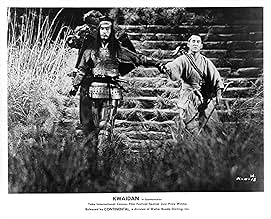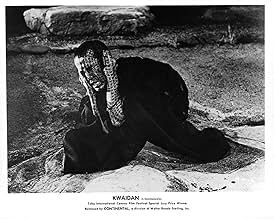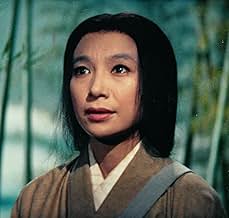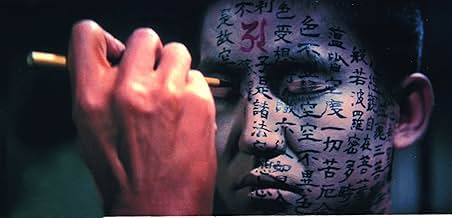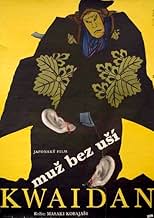CALIFICACIÓN DE IMDb
7.9/10
22 k
TU CALIFICACIÓN
Una colección de cuatro historias tradicionales japonesas con tema sobrenaturales.Una colección de cuatro historias tradicionales japonesas con tema sobrenaturales.Una colección de cuatro historias tradicionales japonesas con tema sobrenaturales.
- Dirección
- Guionistas
- Elenco
- Nominado a 1 premio Óscar
- 5 premios ganados y 3 nominaciones en total
- Dirección
- Guionistas
- Todo el elenco y el equipo
- Producción, taquilla y más en IMDbPro
Opiniones destacadas
'Kwaidan' is an astonishing film, once seen never forgotten. It's labeled horror, but while the four stories within deal with ghosts and the supernatural, I doubt that anyone would be actually frightened watching it. Haunted, yes, scared, no. It's a beautiful movie, very stylized with a very imaginative use of colour. I can't think of anything else I've seen that comes close. Mario Bava, maybe. The movie consists of four stories. I think it's best watched as a whole to let each story blend in to the other, but if forced to choose I would say my favourite segment is the second one ('The Woman In The Snow') which I believe was left out of the version of the movie originally shown outside Japan. 'Kwaidan' is one of those rare movies that leaves you stunned the first time you see it. For me it's equal to 'Rashomon', 'Woman In The Dunes' and 'Branded To Kill' as the most amazing Japanese movies I've ever seen. Each one of these movies blew my mind. It's difficult not to gush about all four. They come with my highest recommendation. I sincerely believe that anybody who watches them will be incredibly impressed. They are all masterpieces.
There's a good bit of discussion of this film as "horror"; may I suggest that it's horrific in the sense of the ancient Greek tragedies. There's no attempt to coerce your Hollywood-abused adrenals into delivering just one more squirt by means of some in-your-face special effect. In fact, for each of these slowly developed stories, once you've understood the premise, the story will unfold pretty much as you've guessed it must, inexorably, relentlessly. The ghosts aren't there to "spook" us, they're to show us our common human spiritual and emotional failings. The horror of a ghost wife, for instance, isn't that her chains drag noisily across the the hardwood parquet floor, but that we've created her by our insensitivity, our misplaced values, or our betrayals.
The visual style is stupendous! The action takes place in a disappeared, iconic world of classical medieval Japan, perfect, and admitting no trace of the reality of modern times. Overlaid is a European Expressionist color sensibility, with emotionally charged color displacements of sky and skin, as if Hokusai and Ernst Ludwig Kirchner had been working cooperatively on the sets and lighting.
This is a wonderful movie. Please ignore attempts to fit it into some box, some genre. Rather look at it as a mature work of art, which happens to choose old Japanese ghost stories as its starting point.
The visual style is stupendous! The action takes place in a disappeared, iconic world of classical medieval Japan, perfect, and admitting no trace of the reality of modern times. Overlaid is a European Expressionist color sensibility, with emotionally charged color displacements of sky and skin, as if Hokusai and Ernst Ludwig Kirchner had been working cooperatively on the sets and lighting.
This is a wonderful movie. Please ignore attempts to fit it into some box, some genre. Rather look at it as a mature work of art, which happens to choose old Japanese ghost stories as its starting point.
The words "beautiful", "lyrical" and "evocative" aren't ones that you would normally attribute to a horror movie, but they are precisely the ones that best describe Kwaidan, a quintet of Samurai Gothics based (interestingly enough) on the writings of an American author by the name of Lafcadio Hearn. Shot in gorgeous, sumptuous color way back in 1964 by director Masaki Kobayashi, Kwaidan is an unusual, unique and quite extraordinary entry in the old horror anthology genre best represented by 1945's Dead of Night and Milton Subotsky's Amicus anthology series (i.e. Dr. Terror's House of Horrors, Tales From the Crypt & Asylum).
Kwaidan differentiates itself from the pack in a number of significant ways. To begin with, all of the episodes eschew the usual O. Henry "twist" endings and deliberately telegraph their punches, case in point being "Hoichi the Earless", which gives away its climax with its very title! This film is also missing the compulsory "wrap-around" story normally employed by anthology films to tie all the stories together, and the horror elements are far more low-key than most horror aficianados are used to. Kwaidan is far less concerned with springing shocks and fraying nerves than it is in exploring the whirlwind of conflicting emotions that swirl in the dark night of the human soul.
"The Black Hair" is the tale of an impoverished samurai who abandons his loyal and loving wife to marry the daughter of a wealthy lord in another province, only to discover many years later that he is still in love with his first spouse. He returns to their decaying old house to find her exactly as he left her, affectionate and forgiving as could be. You know something in this household just ain't right. "The Woman in the Snow" concerns an apprentice woodcutter who encounters an eerily beautiful female ice-vampire - called a "Yuki-Onna - who spares his life on the condition that he never tell a soul about their encounter. (If you saw the last episode of the flaccid Tales From the Darkside movie, on which this was based, you have an idea of how this one ends).
"Hoichi the Earless", easily the most powerful of the bunch, regards a blind biwa (a stringed instrument resembling a guitar) player renowned for his moving rendition of the tragic tale of the battle between the Genji and Heiki clans. Each night he is summoned to the nearby graveyard to chant the epic tale for the ghosts of the warriors who fell in that battle, duped by the spirits into believing that he's performing in the home of a wealthy lord. When Hoichi disocvers that he has been decieved by the dead and refuses to perform for them again, the ghosts exact a terrible revenge.
A note of warning to those deterred by long foreign films: this shimmering jewel in Japanese cinema's crown clocks in at nearly three hours of length and is, of course, fully subtitled. Visually bold, rich and color and texture, and atmospherically photographed with a spine-tingling elegance, I can't guarantee that you'll like Kwaidan, but I think that I can safely assure you'll never forget it. Highly recommended, especially for Japanophiles and those with a taste for high class horror.
Kwaidan differentiates itself from the pack in a number of significant ways. To begin with, all of the episodes eschew the usual O. Henry "twist" endings and deliberately telegraph their punches, case in point being "Hoichi the Earless", which gives away its climax with its very title! This film is also missing the compulsory "wrap-around" story normally employed by anthology films to tie all the stories together, and the horror elements are far more low-key than most horror aficianados are used to. Kwaidan is far less concerned with springing shocks and fraying nerves than it is in exploring the whirlwind of conflicting emotions that swirl in the dark night of the human soul.
"The Black Hair" is the tale of an impoverished samurai who abandons his loyal and loving wife to marry the daughter of a wealthy lord in another province, only to discover many years later that he is still in love with his first spouse. He returns to their decaying old house to find her exactly as he left her, affectionate and forgiving as could be. You know something in this household just ain't right. "The Woman in the Snow" concerns an apprentice woodcutter who encounters an eerily beautiful female ice-vampire - called a "Yuki-Onna - who spares his life on the condition that he never tell a soul about their encounter. (If you saw the last episode of the flaccid Tales From the Darkside movie, on which this was based, you have an idea of how this one ends).
"Hoichi the Earless", easily the most powerful of the bunch, regards a blind biwa (a stringed instrument resembling a guitar) player renowned for his moving rendition of the tragic tale of the battle between the Genji and Heiki clans. Each night he is summoned to the nearby graveyard to chant the epic tale for the ghosts of the warriors who fell in that battle, duped by the spirits into believing that he's performing in the home of a wealthy lord. When Hoichi disocvers that he has been decieved by the dead and refuses to perform for them again, the ghosts exact a terrible revenge.
A note of warning to those deterred by long foreign films: this shimmering jewel in Japanese cinema's crown clocks in at nearly three hours of length and is, of course, fully subtitled. Visually bold, rich and color and texture, and atmospherically photographed with a spine-tingling elegance, I can't guarantee that you'll like Kwaidan, but I think that I can safely assure you'll never forget it. Highly recommended, especially for Japanophiles and those with a taste for high class horror.
Over a time span of some 35 years, I saw Kwaidan twice on the large screen. I liked it the very first time, and it got better when I saw it the second time.
From the very opening when credits were introduced, color ink drops penetrating clear water generated an extremely soothing visual effect. The execution was low-tech, but it goes to show the power of human creativity before the age of fast computer chips. This opening also sets the tone of what you are about to get into - a film of great visual beauty, a film that requires a relaxed and unrushed mental frame of mind to appreciate.
It consists of four stories, all about ghosts, spirits and a blood-sucking woman in white. Some stories are better than the others, and my favourite is 'Hoichi the Earless', which also has the longest running time. It is about escapism, tales of morals, and cinema at its best.
From the very opening when credits were introduced, color ink drops penetrating clear water generated an extremely soothing visual effect. The execution was low-tech, but it goes to show the power of human creativity before the age of fast computer chips. This opening also sets the tone of what you are about to get into - a film of great visual beauty, a film that requires a relaxed and unrushed mental frame of mind to appreciate.
It consists of four stories, all about ghosts, spirits and a blood-sucking woman in white. Some stories are better than the others, and my favourite is 'Hoichi the Earless', which also has the longest running time. It is about escapism, tales of morals, and cinema at its best.
Cinematographer Yoshio Miyajima did a marvellous job, although most of the visuals in this masterpiece are obviously invented by Kobayashi. It is clearly studio-work, but Kobayashi turns that to his advance by making the most marvellous background paintings I've ever seen in a movie and his virtuosity comes to full exposure in the light effects that are fabulous for such an old film. That together with the beautiful colors creates a mesmerizing and sometimes terrifying experience. 'Marco the magnificent' (Patelliere&Howard, 1964) reminded me of the visuals in Kwaidan, because of the beautiful environmental shots and because of the (supposed) history of mixture of eastern and western stories. Forget that movie instantly plz. Another film that has nothing to do with this one, but is brilliant and comparable only because of the episode structure, the fairy-tale nature and great cinematography is Kaos (Taviani, 1984).
Kwaidan has such a haunting effect because of the scary music and the sound effects are unnerving(-ly edited). Some call it horror. I thought the pace was rather slow for horror, but it is a film that does not let go easily. The actors (one of which is Takeshi Shimura) convince enthusiastically and they too make it an entertaining film. According to the user-rating this is Kobayashi's least interesting work of these three: Joi-uchi, Seppuku, and Kwaidan. I can't wait to see the other two, although I don't think they can surpass this masterpiece.
10 points out of 10 :-)
Kwaidan has such a haunting effect because of the scary music and the sound effects are unnerving(-ly edited). Some call it horror. I thought the pace was rather slow for horror, but it is a film that does not let go easily. The actors (one of which is Takeshi Shimura) convince enthusiastically and they too make it an entertaining film. According to the user-rating this is Kobayashi's least interesting work of these three: Joi-uchi, Seppuku, and Kwaidan. I can't wait to see the other two, although I don't think they can surpass this masterpiece.
10 points out of 10 :-)
¿Sabías que…?
- TriviaThe four vignettes were chosen to represent the four seasons of the year.
- Errores(at around 2h 25 mins) In the segment "Miminashi Hôichi no hanashi", Donkai says he covered all of Hôichi's body with the sacred writing, but when Hôichi is writhing on the floor after the ghost's attack, his thighs (which in the shots were supposed to be covered by his robe) are visible for a couple of seconds and are clearly unmarked.
- Citas
Hoichi (segment "Miminashi Hôichi no hanashi"): As long as I live, I'll continue to play the biwa. I'll play with all my soul to mourn those thousands of spirits who burn with bitter hatred.
- Versiones alternativasOriginally a four-episode anthology released in Japan at 183 minutes. The USA version removes the second episode, starring Keiko Kishi and Tatsuya Nakadai, in order to shorten the running time to 125 minutes.
- ConexionesEdited into Spisok korabley (2008)
Selecciones populares
Inicia sesión para calificar y agrega a la lista de videos para obtener recomendaciones personalizadas
2025 Venice Film Festival Guide
2025 Venice Film Festival Guide
See the full lineup for the 2025 Venice Film Festival, taking place Aug. 27 – Sept. 9, 2025.
- How long is Kwaidan?Con tecnología de Alexa
Detalles
Taquilla
- Presupuesto
- JPY 350,000,000 (estimado)
- Tiempo de ejecución
- 3h 3min(183 min)
- Relación de aspecto
- 2.35 : 1
Contribuir a esta página
Sugiere una edición o agrega el contenido que falta


